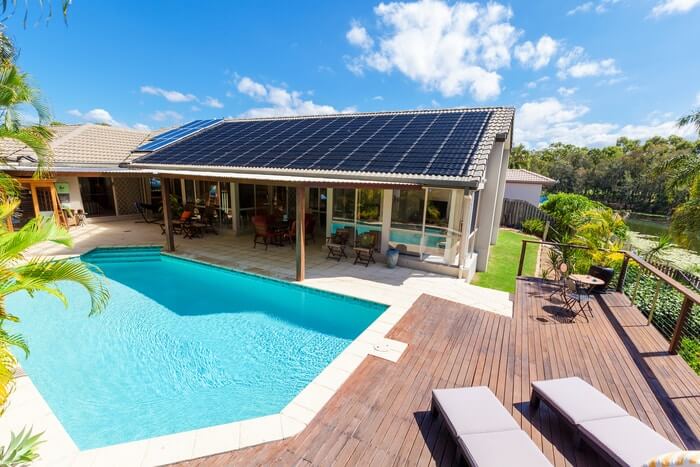Are you doing a solar project?
Modernize can pair you with three to four pros in your area, so you can compare options and save time and money.
There is now enough solar panel capacity to power 18 million American homes, according to the Department of Energy. As solar panel prices have gone down, demand has gone up. There’s a lot to research before installing solar panels — including the solar incentives and rebates out there. So how do you know if solar is right for your home? One of the first things you need to consider is if you have the right roof for solar panels, and what is the best angle for solar panels to be at in your area. The pitch of your roof will impact your solar panels’ tilt.
While there’s a lot of math and science that goes into finding the right tilt, the number that solar contractors and professionals arrive at ensures you are getting the most solar bang for your buck.

What is a Roof Tilt Angle?
The angle of your roof’s tilt is simply the slope of your roof. It plays a pretty big role in determining how your solar panels will be installed. That’s because the sun isn’t always shining directly overhead; sometimes it hits the Earth at an angle. Furthermore, the closer your location sits to the equator, the more directly the sun strikes your roof. Then, there’s the seasonal variation. The Earth orbits around the sun on an ellipsis, not a perfect circle. So the angle of the sunlight in relation to the Earth changes throughout the year.
The best tilt or roof pitch for solar optimizes angles to make sure you get the most sunlight possible for your area and roof orientation. However, not all homes have a roof with a tilt. Afterall, some roofs are flat. But that doesn’t mean that your house is not eligible for solar panels. Installers can mount panels so that they achieve different angles and tilts. In fact, you could even opt for an adjustable mounting system that can be repositioned seasonally to account for the movement of the Earth around the sun, giving you lots of options.
What’s Better: Fixed or Adjustable Solar Panels?
One of the ways solar panel models differ is in their positioning on your roof—in other words, are they fixed or are they adjustable?
As you might guess from their name, fixed panels stay stationary at all times. That makes finding their optimal tilt angle absolutely vital to their overall productivity. Your solar installer should be able to help you with this, but you can also do some preliminary calculations yourself (more on that later). Fixed panels are overwhelmingly the most popular choice among homeowners.
However, if you’re serious about solar and want to maximize your solar production, an adjustable mounting system may be a better choice for your home. These mounts allow you to shift the angle of the panel as often as you want, although most homeowners choose to do it seasonally, two to four times a year. When this adjustment is made correctly, adjustable panels can capture nearly 76% of the available solar radiation, assuming tree shading and other obstructions are not an issue (by comparison, fixed panels only get around 71%). That may sound like a minor difference, but it adds up.
If you’re willing to undertake the task of adjusting panels semiannually, you’ll also be able to better protect your panels from drops in production due to snow coverage. You can just set your panels at a sharper angle to clear them of snow faster.
What is the Optimal Tilt for a Fixed Solar Energy System?
The tilt angle of your roof matters a lot when it comes to a fixed solar system, because once the panels go up, they will stay there unless you have an installer come out and readjust the mount.
There are several factors in your control when it comes to finding the ideal pitch for your solar panels. Solar contractors recommend using the latitude of your home’s location as the degree of tilt. For example, the latitude of Los Angeles, California is 34 degrees, so the tilt of your solar panels would be 34 degrees. Whereas, if you live in Orlando, Florida, your latitude is 28, meaning your solar panels would be at a lower angle than if you lived on the west coast. As most roofs are not flat, your solar contractor will factor the pitch of your roof into the equation.
Calculating Your Optimal Tilt
An energy professional, who can weigh your home’s individual circumstances, can help you determine the very best angle of the solar panels for your home, but there are also some guidelines you can use to help you figure it out ahead of time.
There’s a formula you can use to get a general sense of the right angle for your panels: If your home’s latitude falls between 25 degrees and 50 degrees (all homes in the continental U.S. do), multiply that number by 0.76 and then add 3.1 degrees.
Find the Right Contractor for Your Solar Project
Whether you’re ready to begin your project now or need some expert advice, our network of contractors are here to help. With a few simple questions, we’ll find the best local professionals for you
Finding the Optimal Seasonal Tilt for an Adjustable Solar Energy System
The sun’s path changes throughout the year; the days are longer during the summer, which means you get the most sunlight because of the sun’s summer path. You will find that your solar panels are able to produce the most energy during the summer because of this. During the winter, the sun’s rays are less direct because its path has changed.
If you choose to install an adjustable solar energy system, you’ll need to raise and lower the angle of the panels to account for the shift in seasonal light. For most people, this means rotating them biannually: once at the end of March, and again in mid-September.
If you are able to adjust the tilt of your solar panels, even manually, they will be significantly more efficient. If this applies to you, consider increasing the tilt of your solar panels by 15 degrees during the winter. During summer months, decrease the original tilt by 15 degrees. If you’re unable to adjust your panels, you don’t have to worry. The reason latitude is suggested is that it is between the maximum and minimum angles the sun travels in the sky throughout the year.
In order to adjust the tilt of the panels, homeowners will use a different formula for summer than winter to account for the differing movement of the sun. The ideal tilt for solar productivity is zero degrees—in other words, angled directly toward the sun. Here, again, you need to use your home’s latitude to find the best angle.
- For summer, take the latitude, multiply by 0.93, and subtract 21 degrees.
- For winter, take the latitude, multiply by 0.875, and add 19.2 degrees.
These formulas work best if your panels are oriented toward true-South. More on that below.
What Direction Should Solar Panels Face?
As you’ve read, the pitch or angle of the solar panels are important to their efficiency. But another important factor is the direction your home faces. Pointing your solar panels in the direction with the most direct sunlight is imperative to producing the most energy.
In the northern hemisphere, which includes the United States, solar panels work best when they’re oriented towards true-South. Without getting into a lot of complicated science, the directions on a compass are dictated by the direction of the Earth’s magnetic field lines rather than its geographic latitude. Therefore, facing true-South gets you a more precise estimate of your solar potential.
If you can’t orient your panels facing true-South, you’ll have to adjust the formula we went over in the section about optimal tilt above. These numbers only work for panels if they’re truly facing south. Of course, due to the location of your home or the design of your roof, that may not always be possible. In this case, you’ll need to rely on an analysis from a solar professional.
What about if your southern facing roof has too much shade due to surrounding trees or buildings? You still have options. The eastern sun in the morning and western sun in the afternoon will still provide a good amount of energy for your solar panels to use. If that’s the case, keep in mind that the solar panels you install may not produce the full wattage they say they will.
However, you will still notice a significant decrease in the amount of energy you need from your city’s power grid—and therefore a lower electricity bill each month.
Still have questions about your future panels’ solar energy potential? Visit Modernize’s solar cost calculator to find an estimate, or speak directly with an experienced and knowledgeable representative to get your questions answered quickly.
Find the Right Contractor for Your Solar Project
Whether you’re ready to begin your project now or need some expert advice, our network of contractors are here to help. With a few simple questions, we’ll find the best local professionals for you
Reviews from Real Homeowners
Welcome to Homeowner Resources! We are the Modernize blog. Modernize pairs more than 3 million homeowners a year with pre-vetted contractors in their area. This blog started because we believe homeowners should know everything about their homes, from how their HVAC works to which front door colors they might love. On Homeowner Resources, you can find information on every part of your home, right down to how you can negotiate with contractors to get the best price. Here's more about the blog.
Need a contractor? Learn more about how Modernize finds the right pro for you.






